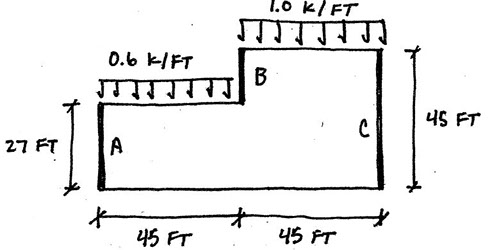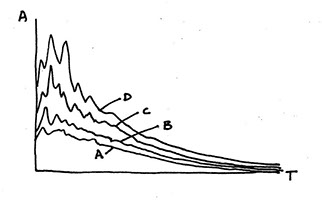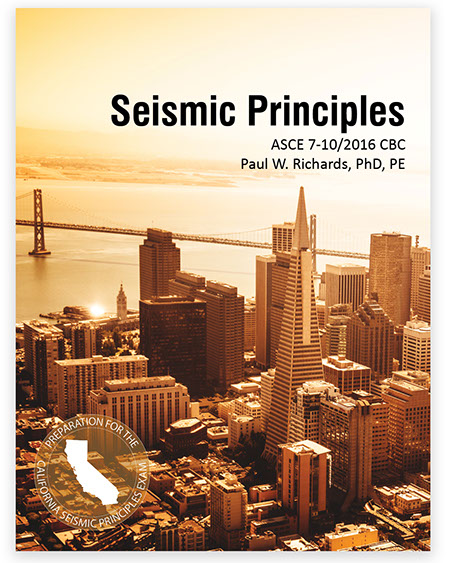Seismic Principles
41. A heavy exterior concrete wall of a one-story building is 18 ft tall, 90 ft wide, and weighs 115 psf. SDS = 0.32g and Ie = 1.0.
What is the out-of-plane design force that the wall imparts on the diaphragm?
(a) 22.7 kips
(b) 23.8 kips
(c) 35.4 kips
(d) 37.3 kips
Solution
Best answer: (c)
Hints
The equations for out-of-plane wall forces are found in Section 12.11.2.1 of ASCE 7. Example 4.24 in Seismic Principles shows how the equations are applied for a typical building. Get your copy.
42. The forces shown below are the diaphragm design force, Fp, distributed in proportion to the mass. The diaphragm is flexible.

What is the maximum collector force?
(a) 13.5 kips
(b) 27 kips
(c) 36 kips
(d) 72 kips
Solution
Best answer: (b)
Hints
The source documents (ASCE 7 and CBC) provide equations for determining the diaphragm design force, but they do not describe how to calculate collector forces. Section 4.11 in Seismic Principles explains how to calculate collector forces. Example 4.23 in Seismic Principles is similar to this problem. Get your copy.
43. A 15-story office building in Seismic Design Category D has partition walls that weigh 8 psf. In calculating the seismic weight, how much partition wall weight should be considered?
(a) 0 psf
(b) 4 psf
(c) 8 psf
(d) 10 psf
Solution
Best answer: (d)
Hint
Section 12.7.2 of ASCE 7 discusses the partition wall weight that should be included in the seismic weight. Section 3.14 of Seismic Principles explains seismic weight and provides six fully-worked examples related to seismic weight calculations. Get your copy.
44. A building will have special reinforced concrete shear walls for the seismic force-resisting system. The shear walls will not be carrying gravity loads.
What is the response modification coefficient that should be used for design?
(a) 4
(b) 5
(c) 6
(d) 7
Solution
Best answer: (c)
Explanation
The response modification coefficient is the R factor. Values for the R factor can be looked up in Table 12.2-1 of ASCE 7. A version of this table is provided in Section 3.9 of Seismic Principles. Special reinforced concrete shear walls show up twice in the table, once under Bearing Wall Systems and again under Building Frame Systems. Since the walls in this question do not carry gravity loads, the R factor from the Building Frame Systems list can be used.
45. A braced frame building has two braced bays on each side of the perimeter and no plan irregularities. However, if one brace were removed, the resulting system would have a torsional irregularity.
What value should be used for the redundancy factor?
(a) 0
(b) 1.0
(c) 1.3
(d) More information required
Solution
Best answer: (b)
Explanation
The redundancy factor is defined in Section 12.3.4 of ASCE 7. Table 12.3-3 outlines requirements in order for the redundancy factor to be taken as 1.0. However, the text says that structures can have a redundancy factor equal to 1.0 without satisfying the requirements of the table, if there are no plan irregularities and at least two bays of seismic force-resisting perimeter framing on every side... Since this building satisfies that requirement, the redundancy factor can be 1.0 even though there is not enough information to check all the criteria in Table 12.3-3.
Section 6.6 of Seismic Principles explains the redundancy factor and provides two fully-worked examples. Get your copy.
46. A two-story shopping center will be constructed with typical light-frame wood construction on top of concrete footings.
Are special inspections required for the concrete work?
(a) No.
(b) Yes, if the Seismic Design Category is D, E, or F; No, otherwise.
(c) Yes, regardless of Seismic Design Category.
(d) More information is required.
Solution
Best answer: (d)
Hints
CBC Section 1705.3 addresses special inspections and testing for concrete. There is a list of situations where special inspections and testing are not required. More information is required to know whether the shopping center meets the exceptions.
Section 13.4 of Seismic Principles explains requirements for special inspections and structural observations. There five fully-work example problems to illustrate typical questions. Get your copy.
47. Cross-grain bending failure is a concern for:
(a) Ledgers
(b) Chords
(c) Collectors
(d) Sill plates
Solution
Best answer: (a)
Explanation
When walls transfer out-of-plane seismic loads to the diaphragm through ledgers, the ledgers may fail due to cross-grain bending. Current codes require walls to transfer out-of-plane seismic forces to the diaphragm through straps.
If you do not know what ledgers look like, you should get Seismic Principles. There are over 700 pictures and illustrations. Get your copy.
48. The figure below shows constant ductility spectra generated from an earthquake time history.

Which of the spectra corresponds to the highest ductility demand?
(a) A
(b) B
(c) C
(d) D
Solution
Best answer: (a)
Hint
See Section 2.10 of Seismic Principles for a discussion of constant ductility spectra. Get your copy.
49. Which is considered the most dangerous form of construction?
(a) Steel buildings that pre-date modern requirements.
(b) Wood-framed buildings that pre-date modern requirements.
(c) Masonry buildings that pre-date modern requirements.
(d) Reinforced concrete buildings that pre-date modern requirements.
Solution
Best answer: (c)
Hint
See Section 8.4 of Seismic Principles.
50. The forces shown below are the diaphragm design force, Fp, distributed in proportion to the mass. The diaphragm is flexible.

What is the maximum chord force?
(a) 5.6 kips
(b) 87 kips
(c) 152 kips
(d) 253 kips
Solution
Best answer: (a)
Hints
Section 4.10 in Seismic Principles explains how to calculate chord forces. Diaphragm analysis is not explained anywhere in ASCE 7 or the CBC. Unless you have the procedures memorized, you will need to have a reference book (like Seismic Principles) handy when you are taking the exam. Get your copy.
